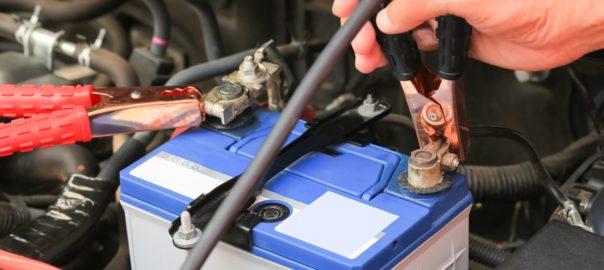When car batteries are fully drained, jumpstarting is a convenient and useful way to get them charged again. In this blog entry, the roadside assistance service and vehicle jump starting experts here at Chicago Towing will detail the best ways to jumpstart vehicles in Chicago with drained or dead batteries.
Jump Starting Cars
Even when your car is parked, your car battery can drain – notably with modern electronic vehicle systems. When car batteries die, you can jump start your vehicle with a jump start cable and another vehicle – however, if this is done without the proper procedure, you can seriously damage your vehicle. A few steps for safe jumpstarting include:
- Bring the car that you’ll use for jumpstarting next to the car with the dead battery – nose to nose, 18 inches from each other.
- Turn off both car’s ignition, and place all automatic transmission cars in ‘park’ mode and manual transmission cars in ‘neutral.’
- Find out which battery terminals are positive and which are negative on both cars. Positive terminals are wider than negative terminals.
- Clamp the end of the positive cable to the positive clap of the dead battery, and ask someone else to connect the other end of the cable to the other battery’s positive clamp.
- Repeat the above procedure with negative cables and negative terminals.
- Start the rescue car in order to start the flow of electricity.
- Start the car with the low battery – if it doesn’t turn on, make sure all connections are tight and properly aligned.
- Then, allow the car with the dead battery to run for – at least – 20 minutes of time to recharge the battery.
- Disconnect cables in the reverse order that you did above.
- NEVER touch two ends of a cable to each other.
How long does a car battery jump start to take?
This can take between a few minutes to 20-30 minutes. If your battery is totally dead, it could take a little longer.
What causes dead car batteries?
High temperatures can cause corrosion in the inner metal grids of batteries, as well as lead electrode failure, lowering battery capacity. High levels of bass vibration can destroy the inner components of car batteries, as well as erosion of the acid within the battery. Alternators – the conducting technology that connects currents in the car’s chain of electricity – can experience issues that cause cars to become undercharged or fully discharged.
Avoiding Dead Car Batteries
Cars need to be driven on a regular basis in order for your car’s alternator to maintain the proper charge level. If you need to keep your car parked for an extended period of time, utilize a battery maintainer or trickle charger device that can extend battery life. Regularly inspect your battery for corrosion and damage. Depending on your environment, car batteries can last between 3 and 5 years. Batteries older than 2 years should be load tested once a year in warm environments, and every 4 years in colder environments.

